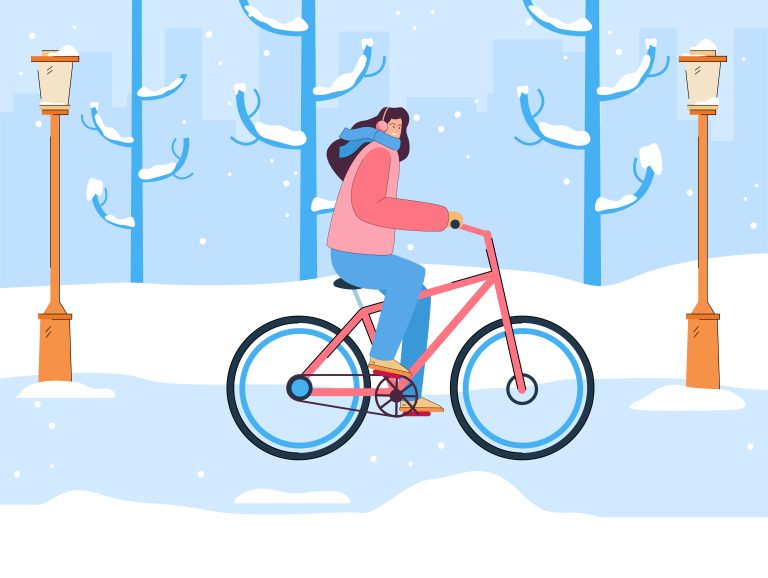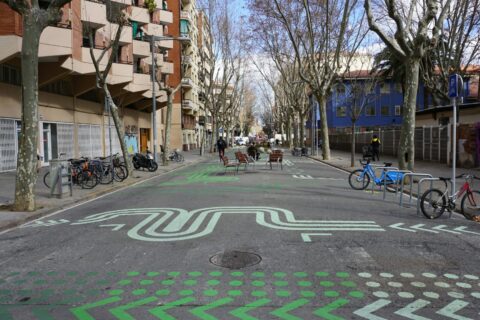
Biking in wet and snowy conditions

The alarm is blaring, raindrops are drumming on the windowsill and you are already quickly canceling today’s bike ride? Not so hastily, my friends! Thanks to today’s tips, you’ll find that even in the rain and even in freezing rain and snow, we can save you more thrifty miles! And you’ll see how proud you’ll be at the finish line.
How to equip a bike
The soup is supposedly the foundation, but in our case, it’s the fenders. Especially the front one, which should cover the wheel casing as much as possible. With a bit of skill, you can “tune” it with a rubber apron (a piece of PET bottle will also do). The rear mudguard doesn’t need to be that long, but it should ideally reach all the way to the center line at the front. This will reduce the likelihood of wet legs and boots.
Also, remember to protect the contents of all panniers (they don’t have to be waterproof) and baskets (they’re waterproof from the factory). It’s always a good idea to have at least an ordinary plastic bag to wrap delicate items in at home.
Large bike panniers are usually waterproof (Ortlieb’s are reliable). Still, their weak points tend to be stressed seams (especially the bottom ones) and zippers. Most of the time, it splashes on them from the bottom. If you ride with them but haven’t checked them yet, you’d better secure yourself with a plastic bag again, so you don’t take wet clothes out of the bag at work to change to.
There aren’t many worse times for a cyclist than when he gets out of a heated workstation (which doesn’t apply to water rescuers) and onto a soaked saddle. So it’s not a bad idea to put a plastic bag or a microtone bag back on the saddle in the morning and fix it with a rubber band (of course there are special covers that will satisfy any aesthete, but these will attract various naysayers). Do this also as a precaution, it often rains during the day.
What to wear
Lighter showers can leave you completely calm. You won’t get too wet and you’ll probably dry out on the way. For heavier rain, it’s better to arm yourself with a bike raincoat. A disposable “condom” that won’t weigh you down can also be an emergency solution. For casual riding over shorter distances (and at slower speeds), a poncho-type raincoat, ideally one that also covers your knees, is useful. At lower speeds, special cycling rain jackets that stretch over your arms and up to the handlebars are also useful. Beware, however, that the water from the raincoat may run right down your legs.
Everyday practitioners, therefore, rely on a raincoat in combination with a waterproof windbreaker and trousers. Shoe covers or lightweight chamois, popular in the Netherlands, which you pull over your trousers, are also practical. If you want to look stylish, take a look at the offer of SegraSegra, a company from Karlin, where they sew durable models specifically for urban cyclists.
Finally, nothing makes you happier than hot tea and spare dry clothes you’ve providentially stored at work.
How to ride
Driving and braking on wet surfaces is different! Watch out for the rim brakes you may have. What you normally brake at ten metres, you can brake at thirty with wet rims. And by then you could be on the other side of the junction. That’s why it’s a good idea to keep them dry by gently “pumping” them occasionally so they’ll work.
Be especially careful of tram tracks that are slippery. The basic rule for crossing them is: the more perpendicular, the better (video). Also, don’t cross them if you are turning or leaning. Fallen leaves and smooth wood can be similarly treacherous.
Rain can also be avoided with the help of various apps and weather radars (e.g. radar.bourky.cz), from which you will soon learn to make a good guess as to how long it will take for the raging storm to pass. In the Czech Republic, the most reliable forecast is probably the one from the ČHMU.
What about after the rain? Put some oil in the chain, which has probably washed out. So you can tread lightly next time!
Well, what if it snows?
Driving in the cold and snow is certainly not unrealistic either. Besides the challenge, winter also means magical experiences for cyclists. It always depends on the conditions, and the frequent shortcomings in winter maintenance of cycling infrastructure must be compensated for with preparation and skill.
A well-lit bike is a basic prerequisite.
Thicker tyres with a coarser tread are better for winter. You can also reduce the pressure in the tubes by a considerable amount.
Park your bike in a warm place and also regularly clean the underside of the bike and moving parts of salt. Keep the components well lubricated with vaseline, which won’t harden in winter.
Don’t leave the battery on electric bikes outside during the day in winter, take it into the warmth at work, even if it doesn’t currently need recharging.
Dress for cycling in winter so that we are a little cold during normal walking – we warm up on the way. The limbs and head deserve special care. We therefore need good quality gloves. Waterproof covers over your shoes or trousers protect you against the spray from overtaking cars, which also serves as additional thermal protection. Instead of a scarf, a neck warmer is more practical and can be rolled up really high. A cap, neck warmer or balaclava can be worn with a helmet. You’ll be at your warmest in temperatures around zero, then there’s no shame in taking spare clothes with you or having it ready at work. In winter, cycling goggles are worthwhile even for the far-sighted. Expect them to fog up, and a cloth, handkerchief or knitted gloves are useful for wiping them off.
The article was prepared in cooperation with the portal Městem na kole, authors of the book Městem na kole (Grada 2018, chapters “How to reach your destination in comfort,” “In the Dark,” “In the rain” and “In the winter”) and the AutoMat association (organizer of the “Bike to work” challenge).
Whether you’re a die-hard athlete or more of a café loafer, give the Bike to Work Challenge a try! The competition is all about regularity. But above all, it’s about good mood.

Bike to Work Challenge leads to higher productivity and higher attendance

The Anti-Lycra Social Club: In Praise of Slowbiking
